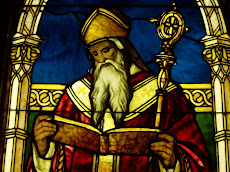The only problem is that this account inverts reality. It is a story about what the Left wishes was the case, but it is not in accord with history. Mike Flynn's post "Witchcraft and the Dark Ages" summarizes the facts concisely. He begins:
"Although some folk apply the term "Dark Ages" to the entire medieval period, others apply it only to the early middle ages and refer to the High Middle Ages as the Early Renaissance. This is done in service to belief, of course. It is not how the historians generally view things. (In fact, those have been abandoning such propaganda labels in favor of century labels.) But in any case, one of the most cherished foundation myths of the Modern Ages is that of the West's struggle to free itself from the violence of religious intolerance. This is almost as basic as the myth of Galileo springing pristine from the brow of Copernicus.The Middle Ages were the age of faith, but more accurately they were the age of faith and reason. When modern science arose, it did so in a period of intense searching for ways to gain power over nature. The Renaissance was a period of great interest in magic and also in experimental science. When the latter proved more effective than the former in giving humans power to manipulate nature, the former was discarded. But while the issue was still in doubt, magic was regarded as important and taken seriously in a way the Church never did. Flynn again:
One aspect of that violence was the witch mania. . .
Now, belief in sorcery had been common enough among the Romans, who distinguished three classes of witches and prescribed death for the worst class. It was common, too, among the Germans, though the details differed. So it's no surprise if the folk of the Middle Ages, who were after all the descendants of those self-same Romans and Germans, also believed in such things.
The Church however either ignored magic or treated it leniently; this for the very good reason that she taught that magic was a mere superstition. St. Patrick's Synod in the 5th century anathematized anyone who believed that there really were witches with magical powers. Charlemagne issued a Capitulary for Saxony that declared it criminal for anyone acting on a heathen belief in magic to burn or devour the flesh of accused sorcerers. (This suggests that pagan Germans did not treat sorcerers very nicely.) The Canon episcopi about the same time declares that women who believe they fly through the air in Diana's train are simply deluded and orders expelled from the congregation anyone who insists on the reality of it.
When Archbishop Abogard of Lyons (9th cent) learned that rustics in his diocese believed that witches destroyed their crops with hailstones and colluded with men from Mangonia (who sailed ships through the sky to steal crops). He felt obliged to tell his flock that men could not control the weather, sail ships through the sky, or wield any magical powers. Also there was no such place as Mangonia. He had to personally intervene to save four "captured Mangonians"."
"Things began to change as the Middle Ages waned into the Renaissance. The cult of Hermes Trismegistus and the Corpus hermeticum - a late Roman compendium of Neoplatonic, Gnostic, alchemical, magical, astrological, and devotional texts - was resdiscovered. (The Middle Ages went in for Aristotle and Euclid; the Renaissance went in for Neoplatonic woo-woo.)Flynn correctly emphasizes the role of the State, rather than the Church, in promoting the witch hysteria of the 17th century. He also debunks the widespread mis-impression that the Church in the Middle Ages promoted belief in magic and superstition. Read the rest here.
The Malleus maleficarum was written by two Dominicans about 1486. The principal author, Heinrich Kramer, was widely recognized as a "demented imbecile" by contemporaries. The bishop of Innsbruck thwarted his attempt to convict women there of witchcraft and forced him out of town. The Malleus competed with the Carmelite Jan van Beetz's Expositio decem catalogie praeceptum, "an icily skeptical treatment of tales of black magic. Of course, exposés never get the circulation of the lurid originals. Look at The Da Vinci Code.
Two things were happening at the beginning of the Modern Ages. The power of the State was increasing and Science was revolutionized into its Baconian form. Jean Bodin (De la démonomanie des sorciers) wrote that witches should be burned at the stake and nations that did not seek out witches and exterminate them would suffer famine, plague, and war, and that torture should be used on the mere suspicion of sorcery. No one so much as accused of witchcraft should be acquitted unless the accuser's bad faith could be convincingly demonstrated. But Bodin was also the first great proponent of the absolute power of the secular state.
England made sorcery a capital crime in 1542 - after the State had nationalized the Church of England. In the same year, in the Concordat of Liège, the Emperor (Charles V) placed sorcery prosecutions entirely in the hands of secular tribunals.
The Great Witch Hunts began."
In the comments to his post, several readers ask for citations for his historical statements, which is a reasonable request. A good source that discusses the historiography authoritatively is David Bentley Hart's Atheist Delusions: The Christian Revolution and Its Fashionable Enemies (Yale U. Press, 2009).





No comments:
Post a Comment